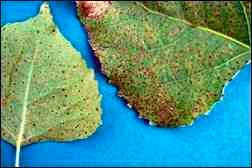Fall colour on the Prairies can be brief. If you throw in the right environmental conditions it can be shorter than brief.
This year, the Balsam Poplar in the river valley kind of turned a sickly dried out looking green that gave way to kind of brown and crispy. Some fall colour, eh? Less than spectacular. In fact, dismal.
Balsam poplars + rain + heat + fungi = green sickly leaves giving way to brown and crispy that fall off the tree before you even see a hint of fall colour.
There are generally two leaf fungi that can cause this reaction in Balsam Poplar. Septoria leaf spot and Linospora leaf blight. In this case the bark was not worse than the blight.
Reaching way back, into the cobwebs of my municipally shattered mind, to my Diseases of Trees and Shrubs class at Guelph U, diseases all need similar factors to line up in order to flourish. You need a disease organism + a susceptible host (Balsam Poplar) + the right environmental conditions (humidity and temperature) to support the growth of the disease.
We got all that lined up this summer and the result was early leaf drop and a lot less fall colour coming across the Battlefords Bridge.
The fungus lives as spores from one season to the next on fallen leaves. The spores can be carried by wind, insects and splashing raindrops.
These leaf diseases affect other types of poplars as well, including the hybrids on our local golf course and in the tree buffer around Territorial Drive.
So does the disease kill the tree? No, but infections year after year can reduce the growth of the tree and cause early leaf drop cutting into our already short display of fall colour.



